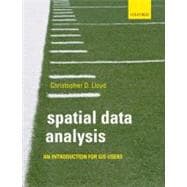
| Introduction | |
| Spatial data analysis | |
| Purpose of the book | |
| Key concepts | |
| Structure of the book | |
| Further reading | |
| Key concepts 1: GISystems | |
| Introduction | |
| Data and data models | |
| Raster data | |
| Vector data | |
| Topology | |
| Databases | |
| Database management | |
| Referencing systems and projections | |
| Geocoding | |
| Spatial data collection | |
| Secondary sources | |
| Remote sensing | |
| Ground survey | |
| Sources of data error | |
| Visualising spatial data | |
| Querying data | |
| Boolean logic | |
| Summary | |
| Further reading | |
| Key concepts 2: statistics | |
| Introduction | |
| Univariate statistics | |
| Multivariate statistics | |
| Inferential statistics | |
| Statistics and spatial data | |
| Summary | |
| Further reading | |
| Key concepts 3: spatial data analysis | |
| Introduction | |
| Distances | |
| Measuring lengths and perimeters | |
| Length of vector features | |
| Measuring areas | |
| Areas of polygons | |
| Distances from objects: buffers | |
| Vector buffers | |
| Raster proximity | |
| Spatial dependence and spatial autocorrelation | |
| Moving windows: basic statistics in sub-regions | |
| Geographical weights | |
| Spatial scale | |
| The ecological fallacy and the modifiable areal unit problem (MAUP) | |
| Merging polygons | |
| Uncertainty in spatial data analysis | |
| Geographic data mining | |
| Summary | |
| Further reading | |
| Combining data layers | |
| Introduction | |
| Multiple features: overlays | |
| Line intersection | |
| Point in polygon | |
| Overlay operators | |
| 'Cookie cutter' operations: erase and clip | |
| Applications and problems | |
| Multicriteria decision analysis | |
| Case study | |
| Summary | |
| Further reading | |
| Network analysis | |
| Introduction | |
| Networks | |
| Network connectivity | |
| Summaries of network characteristics | |
| Identifying shortest paths | |
| Location-allocation problems | |
| Other problems and approaches | |
| Case study | |
| Summary | |
| Further reading | |
| Exploring spatial point patterns | |
| Introduction | |
| Basic measures | |
| Exploring spatial variations in point intensity | |
| Quadrats | |
| Kernel estimation | |
| Distance based measures | |
| Nearest neighbour methods | |
| K function | |
| Applications and other issues | |
| Case study | |
| Summary | |
| Further reading | |
| Exploring spatial patterning in data values | |
| Introduction | |
| Spatial autocorrelation | |
| Local statistics | |
| Local univariate measures | |
| Local spatial autocorrelation | |
| Regression and correlation | |
| Spatial regression | |
| Moving window regression (MWR) | |
| Geographically weighted regression (GWR) | |
| Other approaches | |
| Case studies | |
| Spatial autocorrelation analysis | |
| GWR | |
| Summary | |
| Further reading | |
| Spatial interpolation | |
| Introduction | |
| Spatial interpolation | |
| Triangulated irregular networks | |
| Regression for prediction | |
| Inverse distance weighting | |
| Thin plate splines | |
| Ordinary kriging | |
| Variogram | |
| Kriging | |
| Other approaches and other issues | |
| Areal interpolation | |
| Case studies | |
| Variogram estimation | |
| Spatial interpolation | |
| Summary | |
| Further reading | |
| Analysis of grids and surfaces | |
| Introduction | |
| Map algebra | |
| Image processing | |
| Spatial filters | |
| Derivatives of altitude | |
| Other products derived from surfaces | |
| Case study | |
| Summary | |
| Further reading | |
| Summary | |
| Review of key concepts | |
| Approaches | |
| Other issues | |
| Problems | |
| Where next? | |
| Summary and conclusions | |
| References | |
| Matrix multiplication | |
| Ordinary kriging system | |
| Problems and solutions | |
| Table of Contents provided by Publisher. All Rights Reserved. |
The New copy of this book will include any supplemental materials advertised. Please check the title of the book to determine if it should include any access cards, study guides, lab manuals, CDs, etc.
The Used, Rental and eBook copies of this book are not guaranteed to include any supplemental materials. Typically, only the book itself is included. This is true even if the title states it includes any access cards, study guides, lab manuals, CDs, etc.